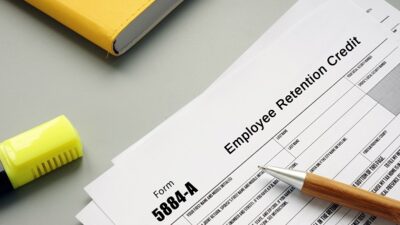Depreciation is the accounting concept that evaluates an asset’s useful life. As the Internal Revenue Service (IRS) explains, depreciable property – which could include equipment, structures, means of transportation, fixtures, etc. – is examined to see how many years the purchase price can be averaged and “deducted from taxable income.” This is in contrast to “full expensing,” which allows companies to write off investments straight away. For dual-use property (personal and commercial), only the portion of property that’s used for business may be depreciated. Property eligible for depreciation must (1) be owned by the business, (2) be used for business purposes/income-producing activity, and (3) have a determinable useful life.
1. Straight Line Depreciation Method
This method of depreciation determines a constant amount to expense annually over the useful life of the property. It’s calculated as follows, with the following example circumstances assumed:
Machinery costing $50,000 with a life of 12 years and $2,500 in salvage value.
Annual Depreciation = (Cost – Salvage Value) / Useful life
= ($50,000 – $2,500) / 12
= $47,500 / 12
= $3,958.33
Considerations
When implementing this method of depreciation, if the asset’s useful life and salvage value is assumed incorrectly, it could skew results. For assets that become outdated prematurely and/or require higher maintenance costs toward the end of their useful life, this method can lead to improper results.
2. Double Declining Balance Depreciation Method
This method, generally speaking, is double that of the straight-line rate.
Annual Depreciation Rate = (100% / Useful life of asset) x 2
Annual Depreciation Rate = (100% / 10) x 2 = 20%
Let’s assume that property, plant, and equipment (PP&E) cost $75,000, will produce for 10 years, and have a salvage value of $6,000.
From there, we work to establish the Periodic Depreciation Expense (PDE)
PDE = Beginning Book Value x Rate of Depreciation
Using the formula for PDE, we get: $75,000 x 0.20 (20 percent) = $ 15,000 for the first year’s depreciation expense.
Then, the first year’s depreciation expense is subtracted from the item’s beginning book value. Ending Book Value = $75,000 – $15,000 = $60,000
To determine each subsequent year’s ending book value, the calculation begins with last year’s ending book value minus the newly calculated annual depreciation expense.
Year 2 Calculation for Ending Book Value: $60,000 – ($60,000 x 0.20 = $12,000) = $48,000
Considerations
This method expenses a greater proportion in the earlier years compared to the later years. This is useful for assets that produce more for a business in their earlier years compared to later years. This method can help businesses depreciate items that lose value quickly, such as electronics, and similar items that become obsolete due to improving technology. It’s not necessarily double or 200 percent of the straight-line rate. It could be more or less than double the straight-line rate. However, the double depreciation rate does remain constant over the depreciation process.
3. Units of Production Depreciation Method
This method takes either the amount of discrete time utilized for production or the tally of items to be manufactured with the production equipment subject to depreciation. It’s calculated as follows:
Depreciation Expense = [(Cost – Salvage value) / (Life in Number of Units)] x Number of Units Produced During Accounting Time Frame.
Let’s assume a piece of equipment costs $100,000, has a projected lifetime production ability of 150 million widgets, and will salvage for $10,000. It’s projected to create an output of 25 million widgets within the accounting year.
Depreciation Expense = [($100,000 – $10,000) / 150 million] x 25 million
= ($90,000 / 150 million) x 25 million
= 0.0006 (unit) x 25 million
= $15,000
Considerations
This method can help businesses, such as manufacturers, that produce discrete items that can be counted and expensed per piece. Depreciation starts when the manufacturer begins to make items and stops when the unit has produced all of its life’s items within a pre-defined time frame.
4. Sum-of-the-Years Digits Depreciation Method
This type of depreciation is calculated as follows:
Remaining Life (RL) of an asset is divided by the sum of the years’ digits (SYD) x Depreciation Base. The Depreciation Base = Cost – Salvage Value
Assuming there are equipment costs of $50,000, with a useful life of 12 years and a salvage value of $3,500. Depreciation Base = $50,000 – $3,500 = $46,500
RL = the remaining life of the asset. When the item starts running, it will have 12 years of remaining life. One year later, or 12 months after usage began, the asset will have 11 years remaining, and so on. For an item with 12 years of useful life, it will be “the sum of the years” or 1+2+3+4+5+6+7+8+9+10+11+12.
The first year of use or the item’s Remaining Life will be 12 / 78 = 0.1538. Then 0.1538 x $46,500 = $7,153.85.
Year 2 would be calculated as 11 / 78 = 0.1410. Then 0.1410 X $46,500 = $6,557.69.
Considerations
This method is another way to speed up the percentage of depreciation sooner, instead of toward the end of the asset’s useful life. The longer the asset is used, the less utility the asset provides to the business. Therefore, it helps businesses take advantage of depreciation sooner. It’s a trade-off for items that require more maintenance as time goes on, as the item’s value drops inversely.
Conclusion
Depending on the type of business and what it produces or provides as a service, understanding how depreciation works can give an accurate picture of a company’s finances and help with navigating tax laws efficiently.




